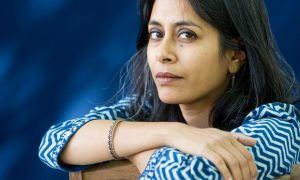Kamila Shamsie in The Guardian:
 Here is a novel that could so easily have been loud. It is set among large events: the fight for Indian independence and the second world war. It features characters from history who enter the lives of the novel’s fictional characters, often to dramatic effect – the poet Rabindranath Tagore, the singer Begum Akhtar, the dancer and critic Beryl de Zoete and the German painter and curator Walter Spies. It has at its heart a young boy whose mother leaves him to live in another country, and whose father responds to this crisis by also leaving the child for an extended period of time, and who is later imprisoned for his anti-British activism. There are many reasons to turn up the volume dial.
Here is a novel that could so easily have been loud. It is set among large events: the fight for Indian independence and the second world war. It features characters from history who enter the lives of the novel’s fictional characters, often to dramatic effect – the poet Rabindranath Tagore, the singer Begum Akhtar, the dancer and critic Beryl de Zoete and the German painter and curator Walter Spies. It has at its heart a young boy whose mother leaves him to live in another country, and whose father responds to this crisis by also leaving the child for an extended period of time, and who is later imprisoned for his anti-British activism. There are many reasons to turn up the volume dial.
But readers of Anuradha Roy, whose previous novel Sleeping on Jupiter was longlisted for the 2015 Man Booker prize, know that shoutiness or showiness is never her style. She is a writer of great subtlety and intelligence, who understands that emotional power comes from the steady accretion of detail. Amid all the great events and characters of history, she chooses as her narrator a horticulturalist known throughout by his nickname, Myshkin – “a man who chose neither pen nor sword but a trowel”. Myshkin is nine years old when his mother leaves him and his father in the fictitious Indian town of Muntazir, and embarks on a new life with Spies. Muntazir is 20 or so miles from the Himalayan foothills, and its name means, in Urdu, “one who waits impatiently”. After his mother’s departure, Myshkin’s life is spent anxiously waiting – for her letters to arrive, for her to return. In later years, he compares that waiting to “blood being drained away from our bodies until one day there was no more left”. The older Myshkin, a man in his 60s, narrates the story. He is the adult version of the child whose blood drained away, now living quietly, more at home among trees than people. In the course of this deliberately self-contained life, a bulky envelope arrives one day. It has something to do with his mother, he knows, and he cannot bring himself either to open it or to throw it away. Instead, his narration takes us back to his mother’s childhood, and then to his own childhood. He is a man seeking to understand why his mother, Gayatri, made the choice she did – and to this end he delves into the unusual freedom of her adolescence, compared with the rigidity and constraint of her married existence in 1930s India.
More here.
